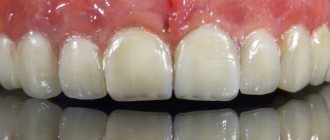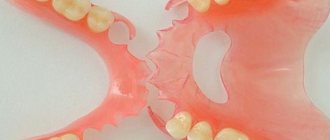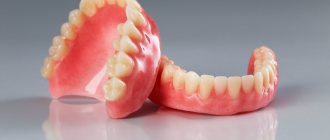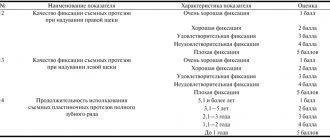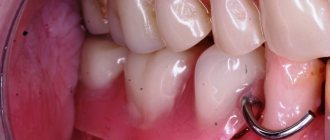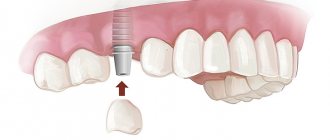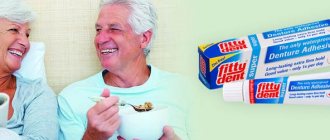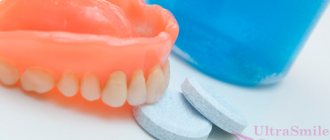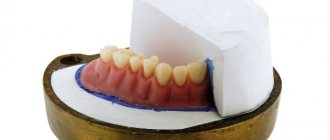Manufacturing of removable dentures from plastic using injection molding
N.N. Abolmasov, A.E. Verkhovsky, O.K. Tarasenkov
Department of Orthopedic Dentistry with a course of orthodontics (head of the department - Doctor of Medical Sciences, Professor N.N. Abolmasov) State Educational Institution of Higher Professional Education "Smolensk State Medical Academy"
The traditional method of manufacturing removable dentures with a plastic base is rightfully considered to be the molding of hot-curing plastic in a dough-like state (polymer + monomer) into a pre-prepared plaster mold. In this case, upon completion of molding, no pressure is applied to the base material located in the mold. Therefore, it is not possible to compact the plastic in order to reduce its shrinkage during the polymerization period and eliminate the occurrence of pores (E. Ya. Vares, 1993). Polymerization shrinkage, according to M.A. Napadova (1978) reaches 7%, even with an optimal powder-liquid ratio. In addition, during the approach of the stamp and the counter-die, excess plastic is forced out between them and prevents their contact, forming a significant burr, or flash (E. Ya. Vares, 1986. At the same time, the amount of residual monomer remains at a significantly high level (6–8%) ". T.I. Ibragimov (2001) notes low thermal conductivity and long adaptation to prostheses due to the large thickness of the base. A prosthesis made of plastic can also be obtained by injection molding under high pressure - injection molding. One of these methods is the technology we used using Palajet/PalaXpress apparatus from Heraeus Kulzer, in which the molded material is introduced into a pre-closed cuvette through a casting channel (Fig. 1, 3, 4).In this case, only a certain amount of mass enters the cuvette, which is under controlled pressure during the entire polymerization process , which can significantly compensate for its shrinkage. For the manufacture of dentures by injection molding, acrylic plastics, polycarbonates, vinyl acrylates, etc. can be used. In addition, cold-curing plastics (self-hardening) can be used, which are considered less durable and contain a larger amount of residual monomer .
Rice. 1. System components for the manufacture of removable dentures by casting Fig. 2. A complete removable denture with plastic teeth is plastered in a position of central occlusion
Rice. 3 Set of wax pins (diameter = 7.0 and 3.0 mm) and their installation to create sprue channels Fig. 4. Opened cuvette after wax melting
The purpose of this work is to study the disadvantages and advantages of manufacturing removable dentures using plastic injection molding.
In Fig. 1 shows the components of a system for the production of removable dentures by injection molding, which includes the following devices and accessories: a pneumatic injection apparatus for the production of complete and partial removable dentures (the apparatus is automatically adjusted to a working pressure of 4 bar, and accessories are attached to it: a cuvette for polymerization , retaining rings and container for the cuvette, injection cylinder, apparatus for removing rings from the cuvette or puller), an automatically controlled apparatus for the polymerization of cold- and hot-curing plastics.
We manufactured 6 experimental complete and 4 partial removable plate dentures for the upper and lower jaws, as well as 14 dentures for patients (8 for the upper and 6 for the lower). Of these, 6 are partial and 8 are complete removable plate dentures. All patients are monitored at the dispensary. 6 patients who had been using complete and partial removable dentures for 1–2.5 years were invited for re-examination.
The functional diagram of this equipment is specially combined with the plastic processing method. To work with this device, we chose cold polymerized plastic. Cold polymerization was carried out at a working pressure of 2 bar, which is precisely regulated thanks to the built-in pressure relief valve. The polymerization process occurs automatically within 30 minutes and is controlled by a computer in accordance with the selected program.
The sequence of the technological process for the manufacture of dentures can be presented as follows: obtaining anatomical and functional impressions (casts), determining the central relationship of the jaws and setting the teeth (using glass or calotte) according to generally accepted methods. In Fig. Figure 2 shows a complete removable lamellar denture with plastic teeth, plastered into the middle anatomical articulator in the position of central occlusion.
For injection molding, a special collapsible cuvette is used, consisting of two halves held together by retaining rings. The inside of the cuvette is immediately lubricated with Vaseline, which will subsequently make it easier to remove the model from the plaster. A plaster model with a wax composition of the prosthesis base is cast (class III gypsum is used) in the center of the lower half of the cuvette (the lower half of the cuvette does not have pins, that is, pins). After crystallization of the gypsum, the inlet (7 mm in diameter) and outlet (3 mm in diameter) channels are filled with wax pins of the appropriate cross-section (Fig. 3). The surface of the plaster is coated with insulating varnish. Then the lower part of the cuvette is closed with the upper half, connected with compression rings, which are tightened only by hand (using a hammer is unacceptable!). The cuvette is placed on a vibrating table and filled with plaster in two stages to facilitate its subsequent opening. The first portion of plaster is poured just enough to cover the artificial teeth. After crystallization of the first portion of gypsum, its surface is covered with insulating varnish, and then the cuvette is filled with a second portion of gypsum to the upper edge of the cuvette.
Once crystallization is complete, the compression rings are removed and the cuvette is placed in hot water (approximately 80 °C) for 5 minutes. Then the cuvette is opened, the remaining wax is removed with clean, hot water (without adding chemicals) (Fig. 4). The surface of the warm plaster in contact with the prosthesis is insulated by applying two thin layers of insulating varnish. The surface of the teeth facing the base is processed with a diamond-coated cutter to improve subsequent adhesion to the plastic. For the same purpose, a special adhesive is used, which is applied twice to the treated surface of the teeth. After the first application, you need to let it dry for 60 seconds. After applying the second layer of adhesive, it remains active for 10 minutes, during which time the cuvette must be closed with compression rings and installed in the injection apparatus.
To produce removable dentures using injection molding, we used cold-curing plastic, which is a two-component “powder-liquid” system. Polymer and monomer are mixed in a 2:1 ratio. For a complete removable denture on the upper or lower jaw of medium size, 30 g of powder and 15 ml of liquid are required. Simple and reliable dosing is achieved by using a system in the form of two connected vessels, supplied with the plastic. The correct ratio of ingredients is achieved by filling a special vessel with powder and liquid to the same level (Fig. 5a). Liquid is poured into a glass mixing container, and then the appropriate amount of powder is added. The plastic is mixed with a spatula until it becomes a homogeneous mixture. Air bubbles are removed by tilting and simultaneously rotating the vessel.
Rice. 5a. Mixing PLA components in a special vessel in a ratio of 2:1 Fig. 5b. Liquid plastic is slowly poured into the prepared cylinder liner
For injection, special cups are used, consisting of a cylinder, a piston and a lid with a pipe. A plastic plunger is inserted into the bottom of the injection cup cylinder to form a container for the plastic dough. Liquid plastic is slowly poured into the prepared cylinder liner (Fig. 5b). It is necessary to ensure that the mixture does not flow down the inner wall of the cylinder liner, since sediment on the walls above the level of the mixture can lead to its heterogeneity. After loading the cylinder liner with plastic, its surface should become matte, which indicates full maturation, that is, readiness for injection molding. For injection, a metal injection cylinder is used, into which an injection cup with prepared “plastic dough” is inserted, and a lid with a pipe is placed on top, and the cylinder is hermetically sealed. The cylinder is then inserted into the injection apparatus, and using a lever, compressed air is supplied to the plunger of the apparatus, creating the desired pressure.
The moment the plastic cuvette appears from the outlet channel shows that it is completely filled (Fig. 6). After a certain amount of plastic comes out of the opening of the cuvette's outlet channel, it is closed using a valve. The filled cuvette is under pressure for 5 minutes, during which the plastic loses its fluidity and turns into a rubber-like state (Fig. 7a). After 5 minutes of continuous pressure, the cuvette is removed and placed in a special container (Fig. 7b).
Rice. 6. The appearance of plastic from the outlet channel of the cuvette
Fig.7a. The filled cuvette is under pressure Fig. 7b. The cuvette is removed and placed in a special container; polymerization of plastic in a special apparatus
Next comes the process of plastic polymerization, which we carried out under automatic control in a special apparatus (Fig. 7b). Tap water is poured into the polymerizer container, the Select button sets the desired temperature mode (for this plastic 55 ° C), and preheating is turned on, which is indicated by a flashing light. Stopping flashing (after about 15 minutes) indicates that the water has reached the set temperature.
Upon reaching the desired temperature, the container with the cuvette is lowered into the polymerizer container and tightly closed with a lid (Fig. 7b). The polymerization time is set on the device panel (for this plastic 30 minutes), and the Start button starts the process. The following indicators on the display indicate the normal progress of polymerization:
- heating indicator – a constant temperature of 55 °C is maintained in the polymerizer container;
- indicator of the presence of pressure in the polymerizer container;
- digital timer displaying the time remaining until the end of the polymerization process.
When the set time has elapsed, a beep sounds. The heater automatically turns off and the pressure in the polymerizer tank is “bleeded off,” after which the cuvette is removed and cooled to room temperature within 30–60 minutes. It is important to note that slow cooling, i.e., long exposure, provides better fit and accuracy of the prosthesis than a rapid cooling cycle. Compression rings are removed from the cuvette using a special device, which is opened using a plastic or rubber hammer. Do not use a metal hammer, as metal tools can damage the brass cuvette, which, in turn, can lead to errors during its subsequent use. After removing the prosthesis and separating the sprues, you can begin grinding and polishing it (Fig. 8).
Rice. 8; 8.1. Opened cuvette; The model is easily separated from the plaster...
In conclusion, it should be noted that based on the results of our research, the following conclusions can be drawn:
- the time of the laboratory process for manufacturing a prosthesis is reduced, according to preliminary data, by 2–3 hours compared to the traditional method;
- when removing the prosthesis from the ditch, there is absolutely no burr (burst), which, when cast in the traditional way, leads to an increase in the interalveolar height; the latter, in turn, leads to the fact that when applying a prosthesis, the doctor spends at least 20 minutes on correcting the occlusal surface, creating an almost new occlusal relationship, although this was not required when checking the design;
- the amount of plastic consumption is reduced due to precise dosage;
- the possibility of “underpacking” of plastic is excluded;
- good, accurate modeling of the wax base is transferred to the plastic practically without distortion;
- dentures are easier to grind and polish;
- A positive attitude of patients towards the manufactured prostheses was revealed.
Rice. 9; 9.1. Complete removable plate denture for the upper jaw after pre-treatment and after grinding and polishing
Clinical testing of removable plate dentures made by injection molding in the Palajet/PalaXpress apparatus from Heraeus Kulzer showed their higher functional and aesthetic value. A survey of patients revealed a significant reduction in the number of corrections and adaptation time after the application of prostheses. This, apparently, was also facilitated by the higher aesthetic qualities of the prostheses.
The described technology ensures their high accuracy, and at first glance, the absence of all types of porosity, and therefore a reduction in the amount of residual monomer, compared even with hot-curing plastics polymerized without pressure. But these assumptions need to be verified by laboratory studies. Continued research is planned to study residual monomer, adsorption phenomena and microbial invasion of removable dentures.
Article provided by the magazine “Dental Technician”
HOT CURING PLASTICS PRODUCED BY INDUSTRY
The Kharkov plant of medical plastics and dental materials (now JSC STOMA) produces the following hot-curing powder-liquid acrylic materials.
Ethacrylic is used for the manufacture of denture bases for partial defects in the dentition and toothless jaws, as well as for orthodontic purposes. The powder is a ternary copolymer of methyl methacrylate, ethyl methacrylate and methyl acrylate (monomer ratio 89, 8 and 2%, respectively), plasticized (1% dibutyl phthalate - DBP) and colored pink during the polymerization process. The powder is clouded with zinc oxide, the liquid is a mixture of methyl methacrylate and ethyl methacrylate, respectively.
wearing by weight 3:1, inhibited by hydroquinone or diphenylolpropane (DPP). Ethacrylic uses the principle of internal plasticization due to the introduction of methyl acrylate units.
Acrel is a plastic for denture bases with a three-dimensional structure. The powder is suspension PMMA, colored with dyes and plasticized with DBP (3%) during the synthesis process. Cloudy with ZnO (1.3%) or TiO2 (0.5%). The liquid is methyl methacrylate containing the cross-linking agent methylol methacrylamide CH2 = (CH3)CO-NHCH2OH and an inhibitor. The three-dimensional structure is formed during the polymerization of the molding mass. Acrylic has higher hardness, lower water absorption, and increased heat resistance.
Colorless plastic is used for the manufacture of denture bases, as well as for other purposes of orthopedic dentistry. The powder is a suspended PMMA containing tinou-vin, which gives the plastic color stability and protects it from aging under the oxidizing effect of atmospheric oxygen. The liquid is inhibited methyl methacrylate.
Ftorax is used for the manufacture of denture bases. Fluorax powder is a grafted copolymer of methyl methacrylate (MMA) to fluorine rubber and vinylidene fluoride in a 1:2 ratio.
Dentures made from fluorax have high physical and mechanical properties, withstand alternating loads well, and in color and translucency they closely imitate oral tissue.
Acronil is used for the manufacture of denture bases, maxillofacial and orthodontic appliances, removable splints for periodontal disease and other purposes. Acronyl powder is a graft copolymer of MMA to polyvinyl ethyl al.
Chapter 15. Basic construction materials
The graft copolymer is obtained through the suspension polymerization of a 5% solution of polyvinylethylal in MMA. The suspension powder is a mixture of PMMA and graft copolymer.
The liquid is methyl methacrylate containing triethylene glycol demethacrylate, an inhibitor and an antiaging agent as a cross-linking agent. Acronil has good strength properties, low water absorption and long-term durability.
Bakryl is a new material for denture bases, developed by KhZMP and SM together with the Central Research Institute of Dentistry (Voskresenskaya I.B. et al.). Bacryl is a high-strength base material characterized by resistance to cracking, abrasion and high impact strength. Bacryl powder is PMMA modified with elastomers during the suspension polymerization process. Low molecular weight copolymers of butyl acrylate rubber, allyl methacrylate (AMA) and MMA are used as modifiers. The modifier consists of a core and a shell. The core is butyl acrylate rubber, “lined” with allyl methacrylate, the shell is a copolymer of MMA and AMA. Polymerization product
tions is a heterogeneous system in which particles of the elastic phase are dispersed in a glassy matrix. Bacryl liquid is DPP-inhibited methyl methacrylate (Fig. 15.2).
Stom-Acrylic. In Russia in 1999, a polymer composition based on acrylic acid copolymers of the first type (hot processing), first class (powder + liquid) was developed, which is used in dentistry as a structural material (ISO 1567), in particular for the manufacture of bases for removable dentures . The developers are teams of employees from StomaDsnt CJSC (Tomilino village, Moscow region) and the Yarsintez Institute of Organic Synthesis (Yaroslavl). The Committee on New Technology of the Ministry of Health of the Russian Federation recommended this plastic for production, and in 2000 the industrial production of plastic began.
Plastic is available in traditional forms: powder and liquid. The powder is a suspension copolymerizate of methyl methacrylate (molecular weight about 200,000-300,000) and butyl methacrylate (in a ratio of about 90 and 10%, respectively), plasticized with oligo-glycerin methacrylate, colored by dusting with an inorganic pigment, clouded with titanium dioxide.
Rice. 15.2. Hot-curing plastics produced by industry.
Section II. Materials used for the manufacture of plate dentures for complete loss of teeth
Rice. 15.3. Plas, developed by JSC Stoma Dent.
Inorganic iron oxide is used as a pigment. The polymer particles have a spherical shape with an average size of 55-70 microns. The liquid is methyl methacrylate, inhibited by diphenylolpropane with the addition of a cross-linking agent and stabilizers (Fig. 15.3).
A study was carried out of various physicochemical properties, possible toxic effects, as well as the influence of polymerization methods and technological regimes on these properties. Research has shown that by changing the method and modes of plastic polymerization, it is possible to achieve an optimal balance of physical and mechanical properties with minimal toxic effects.
The work of N.N. Malginov (2000) shows that the minimum content of residual monomer (0.046-0.08 mg/l), below the maximum permissible level (MPC - 0.25 mg/l), is found in plastic, the polymerization of which was carried out using microwave energy. But at the same time, the fragility of the material increases and its physical and mechanical properties deteriorate. Thus, the bending strength during microwave polymerization decreases and is about 91 ± 3 MN/m2. The modulus of elasticity in bending (E) also decreases from 2557 to 2496 MN/m2. Knowledge of these parameters allows the doctor
choose the optimal clinical solution. Consequently, when determining the polymerization technology, the doctor can set various properties of the prosthetic material depending on the requirements of the clinical situation.
The work of M.V. Dikanova (2003) also substantiates the effectiveness of the clinical use of removable plate dentures made from domestic base materials.
AKR-MV. The use of traditional acrylic compositions for the manufacture of prostheses using the MV polymerization method revealed the instability of the results obtained; in some cases, porosity and uneven hardening of the prosthesis base were noted, especially in the area of its edges.
In 2004, I.Ya.Pogorovskaya, T.F.Sutuchina, V.K.Leontyev, K.N.Rudenko created a new acrylic material specifically for polymerization in the laboratory of materials science, development and physical and chemical testing of dental materials of TsNIIS in microwave ovens. The developed base material AKR-MV allows the production of removable dentures from it using a short-term plastic curing mode - 3 minutes at 100% power, which makes it possible to increase labor productivity.
Chapter 15. Basic construction materials
Rice. 15.4. Materials based on polyurethane “Dentalur P” and “Dentalur”.
The method of polymerization of base materials using microwave energy on a Denta-MV dental unit makes it possible to obtain removable dentures with increased fracture strength, dimensional accuracy, and a reduced amount (0.125 mg/l) of residual monomer. In physical, mechanical and biological studies of AKR-MV, better performance was obtained in comparison with similar materials.
M.Yu.Ogorodnikov, Yu.M. Alter, V.A. Berestnev, B.P. Markov, V.Sh. Pasternak in 2004 developed composites for the manufacture of bases for removable pro-
fabrics and an elastic lining layer based on polyurethane. These materials are called “Dentalur” and “Dentalur P”. The materials are injection molded polyurethanes. The production of products from these materials is based on the principle of liquid molding or free casting. To work with “Dentalur” and “Dentalur P”, special injection cuvettes are required. After filling the mixture, the cuvettes are thermostated at 90°C for 30 minutes. The prosthesis is well processed and polished (Fig. 15.4).
According to the authors, the material is completely harmless and in all physical and mechanical properties surpasses ac-
Section II. Materials used for the manufacture of plate dentures for complete loss of teeth
ril plas (elastic lining material) connects well with the base. The authors point out that the shrinkage of Dentalur is significantly less than that of acrylic plastics. Acrylic teeth connect well with Dentalur. Dentures made from Dentalur are practically not susceptible to breakage.
15.5. COLD POLYMERIZED PLASTICS
Cold-cure acrylic plastics are compounds that cure spontaneously at room temperature. Depending on the composition of the compound, the polymer can be hard or elastic. Cold-curing plastics (CCP) are widely used in dentistry for correcting (relining) dentures, repairing dentures, making temporary dentures, splints for periodontal disease, models, and individual impression trays. PCS has gained a strong place as filling materials. Cold-curing plastics have a number of advantages over hot-curing plastics, but are inferior to them in some respects. The technology for processing PSW is simpler, no heating equipment is required, there is less change in product dimensions, less residual stress in products, repair of the prosthesis can be done quickly in the presence of the patient. In some cases, self-curing materials cannot be replaced by hot-curing plastics. At the same time, self-hardening plastics are inferior in strength and contain a larger amount of residual monomer. Thus, hot and cold curing plastics do not exclude, but complement each other. The technology for producing cold-curing plastics differs from manufacturing
hot-curing plastics in that during the synthesis an initiator is introduced into the polymer powder in an amount of 1.5%, and an activator is added to the liquid.
Compound. Powder is a suspension homo- or copolymer, colored and turbid and containing a component of the redox system (usually an initiator).
Plastic liquids have the following composition: 1) linear polymers (monomer or mixture of monomers, OBC activator, inhibitor); 2) polymers of three-dimensional structure (monomer or mixture of monomers, OBC activator, cross-linking agent, inhibitor). The production of dental structures from cold-curing polymer-monomer materials proceeds according to the following scheme:
Polymer + initiator + monomer + activator + inhibitor ->
OBC^
polymerizate + heat of polymerization.
Properties. The curing of acrylic compounds used in dentistry is due to the initiating action of the oxidation-reduction system (ORS). The main components of OBC are the initiator and activator. Organic peroxide can be used as an initiator; benzoyl peroxide is usually used. Various compounds are used as activators: tertiary amines (primary and secondary ones inhibit the polymerization process), mercaptans, sulfinic acid derivatives, ascorbic acid, etc. In addition to the initiator and activator, some OBCs also contain promoters.
The radicals that initiate the polymerization process are formed during the decomposition of benzoyl peroxide. As can be seen from the kinetic curves of the decomposition of benzoyl peroxide obtained at different temperatures, the rate of decomposition depends
Chapter 15. Basic construction materials
on temperature and begins to decrease noticeably from the moment 65-75% conversion is reached. For the effective initiating action of benzoyl peroxide, heating to a temperature above 65 ° C is required, at which vigorous decomposition of the peroxide begins. The activator reduces the activation energy for the decomposition of benzoyl peroxide, which is equal to 126 kJ/mol, and the decomposition of the peroxide begins at room temperature. OBC is the most important criterion for the quality of gas and chemical treatment. This system must: 1) ensure complete monomer conversion; 2) do not cause changes in the color of the polymerizate under the influence of solar radiation and endogenous processes; 3) be non-toxic; 4) be stable; 5) initiate the polymerization process at minimal concentrations; 6) provide the necessary working hours. To avoid premature polymerization, the activator is usually introduced into the liquid, and the initiator into the powder.
The great practical importance of PCO has stimulated a sharp expansion of research into the creation of cold polymerization OBCs.
Tertiary amines (dimethylaniline) were first proposed as cold polymerization activators in 1943 by Schvebel and Tromdorf. Based on this activator, the first XO plastics AST-1, AST-2, AST-2A and styracryl were produced in the USSR (1952). It soon turned out that the use of dimethylaniline and other tertiary amines leads to a change in the color of the polymer. This occurs as a result of endogenous processes in which the amine is involved. Strubell found that the color and light fastness of plastic depend on the nature of the tertiary amine.
OBC based on mercaptans.
OBC of the peroxide-mercaptan type is widely used for the vulcanization of rubbers and can
used for curing dental acrylic compounds at room temperature. XO Orthofil plastic (Great Britain) contains OBC of the peroxide-mercaptan type. In the reaction between peroxide and mercaptan, the latter plays the role of a reducing agent.
To create acrylic compounds in dentistry, lauryl mercaptan C|2H25SH (synonym - dodecyl mercaptan) is used as an activator. The advantages of these OBCs include the color fastness of the polymer. The OVS currently used cannot be considered perfect. The search for new systems is carried out in two main directions - increasing color stability and increasing monomer conversion.
Preparation of molding mass. The technology for preparing the PCO molding mass is identical to that described. From each batch you can only manage to mold one product. During polymerization, the mass experiences slight thermal expansion, so the pressure inside the mold does not rise as sharply as during hot polymerization. At room temperature, polymerization of most materials occurs in 20-30 minutes. Acceleration of curing can be achieved by immersing the mold in water heated to 37°C. When preparing the molding compound, it is necessary to take into account that volumetric shrinkage depends on the monomer/polymer ratio and increases with increasing this ratio.
| Monomer/polymer | Volumetric shrinkage, % |
| 1:3 | 5,8 |
| 1:2 | 7,8 |
| 1:1,5 | 9,3 |
Linear shrinkage (taking into account technological methods) of XO plastics is
Section II. Materials used for the manufacture of plate dentures for complete loss of teeth
on average from 0.15 to 0.5%. The powder/liquid ratio recommended by the manufacturer must be strictly followed.
The polymerization rate of PCO depends on the following factors: 1) the initial temperature of the monomer and polymer: high temperature (above 30°C) causes rapid polymerization; upon cooling (below 5°C), the process slows down sharply, and at negative temperatures the reaction practically stops; 2) the amount and nature of the activator and initiator; 3) the degree of dispersion of the powder and its molecular weight: the finer the powder and the lower the molecular weight, the faster the swelling and polymerization occurs; 4) monomer/powder ratio. Reducing the monomer/powder ratio shortens the polymerization time. An excess of monomer slows down the process, but at the same time a higher temperature of the polymerized product is observed and shrinkage increases, which ends after 3 hours. The polymerization process, as already noted, is exothermic. The heat of polymerization of the MMA monomer is 78.7 kJ/mol.
When mixing powder with liquid, the resulting molding mass retains its plasticity and the temperature does not increase noticeably. Induction period at point A
goes into a rapid process of development of the polymerization reaction, and the temperature quickly rises. After curing is complete, the temperature of the polymer decreases due to heat transfer to the environment. The temperature jump and the duration of the induction period, which determines the viability of the compound, depend on the mass of the polymerizing polymer-monomer mixture, the redox system and the initial temperature of the liquid and powder. With an increase in mass to 50 g, a sharp increase in the temperature jump is observed. Behind-
The dependence of the thermal effect on the size of the polymerizing mass results in a higher conversion of the monomer in the thick parts of the product (prosthesis, etc.). This means that thin sections of the product have relatively lower mechanical strength because they contain more residual monomer. Due to the fact that the temperature during PCO polymerization is below 100°C (the boiling point of the monomer is 100.3°C), the polymers are characterized by the absence of pores and cavities caused by the boiling of the monomer. Depending on the type of work, the molding compound is used at various stages of swelling.
Stage I - sand. It appears immediately after mixing the powder with the liquid and, depending on the ambient temperature, can last from 30 s to 5 minutes or more. At a temperature of 10°C it lasts about 5 minutes, at 15-18°C - 3 minutes, at 18-22°C - 1-2 minutes, and at 25°C it ends in 0.5-1 minute. In the sand stage, the monomer-polymer mixture is unsuitable for use.
Stage II - viscous, stretchy threads. The initial period of this stage is characterized by the appearance of stretchy threads, stickiness of the mass, high plasticity and fluidity. At the beginning of stage II of swelling, the molding mass is used for work requiring adhesion. After curing, the molding compound applied to the base of the prosthesis forms a strong connection.
Stage III - dough-like. The molding mass at this stage of swelling is characterized by loss of stickiness, good plasticity and lower fluidity. In this state, it is convenient to form the molding mass on plaster models, preparing protective palatal plates, replacing, shaping and obturating dentures, Porta splints, individual trays, orthodontic
Chapter 15. Basic construction materials
dental devices and other dental structures. The mass can be used for relining dentures in all cases, as well as when it is necessary to obtain an imprint of the relief of the prosthetic bed in conditions of functioning dentures, when it is necessary to develop significant chewing pressure.
Stage IV - rubbery. At this stage, the molding mass retains its given shape even with minor short-term mechanical impact on it. During relining, the denture is removed from the oral cavity when the molding mass is already in the rubber-like stage. In the case of relining partial dentures with the presence of converging and diverging teeth in the oral cavity or teeth with well-defined equators, the dentures are removed from the oral cavity only after reaching a rubber-like state. Removal at III of swelling will result in distortion due to tension. If you skip stage IV, the plastic will harden and the prosthesis cannot be removed from the mouth without sawing. When monitoring the curing of the polymerizing mass, it is necessary to pay attention to the thinner areas of the prosthesis, since they cure more slowly than the thick ones. It should be noted that the polymerization of the monomer-polymer system from the beginning of mixing to curing is a continuous process without sharp interstage transitions.
Optimal pressing mode for cold-curing plastic products. The main method of processing PSW, ensuring the production of a high-quality product, is pressing. An important technological parameter for processing PSW is determining the moment of pressure application. When pressure is applied before the required time, the product is obtained with large shrinkage and unsatisfactory surface quality.
| Rice. 15.5.Apparatus for polymerization of cold polymerization plastics. |
sti. Products with the required accuracy can be obtained only with a sharp increase in specific pressure. The working time of the PHO is significantly affected by a change in ambient temperature even by 2-3°C, and this circumstance causes difficulties in determining the moment of application of pressure. The methods used for manufacturing dental structures from XO compounds at room temperature without pressure are not optimal. The polymer is less dense and has lower physical and mechanical properties (Fig. 15.5).
Section II. Materials used for the manufacture of plate dentures for complete loss of teeth
One of the possible options for optimizing the technology of pressing products from PCO is to carry out the final stage of polymerization under compressed air pressure. Figure 15.5 shows an apparatus for the polymerization of products made from PCO. It is a hermetic vessel, inside of which a pressure of 0.3-0.5 MN/m2 is created by air heated to 40-45°C. Inside the apparatus there are shelves on which products are placed for polymerization. Control and maintenance of the set temperature is carried out using a thermocouple interlocked with a temperature relay and an electric heater. The device can be made by converting the ultrathermostat UT-15.
A rack is placed in a preheated apparatus, on which plaster models with products made of PCO, which are in a rubber-like stage, are installed. The device is sealed and a pressure of 0.3-0.5 MN (3-5 atm.) is created. The pressure is controlled using a pressure gauge. If the pressure exceeds, the safety valve is activated. Through
After 15-20 minutes, the finished products are removed from the apparatus.
Comparative characteristics of hot and cold curing plastics
PCOs are inferior to hot-curing plastics in a number of indicators, but this is compensated by their exceptional ease of use and better dimensional stability. Polymerization of PCO is accompanied by lower monomer conversion; therefore, they contain 5–10 times more residual monomer. This leads to faster aging of the polymer and a decrease in strength characteristics. As a result of leaching of the monomer from the surface of the product, the structure of the polymer is loosened, which leads to a change in a number of properties of the product. Thus, when the monomer content in the polymer decreases from 8.5 to 0.9%, the heat resistance increases from 52 to 130°C, and the Brinell hardness increases from 70 to 194 MN/m2. PCO (linear) exhibit higher hygroscopicity (water absorption >0.7 mg/cm2) than hot-curing plastics and contain
Table 15.2
Some indicators of cold and hot curing plastics
| Property | Acrylic plastics | |
| hot curing | cold cure | |
| Compressive strength, MN/m2 | 75,9 | — |
| Modulus of elasticity, MN/m2 | 3,8- 103 | 2-105 |
| Static bending strength, MN/m2 | 190-130 | |
| Microhardness, MN/m2 | 200-270 | 150-200 |
| Water absorption, mg/cm2 | 0,4-0,6 | 0,70 |
| Water solubility, mg/cm2 | 0,02 | 0,025 |
| Residual stresses in the product, MN/m2 | from 0.1 to 3.5 | from 0.1 to 2 |
| Residual monomer, % | 0,1-0,5 | 3,5-5,0 |
| Color fastness | Satisfactory | Satisfactory with stabilizer |
| Manufacturability | good | Excellent |
Chapter 15. Basic construction materials
large amounts of residual benzoyl peroxide, monomer, activator, which is a prerequisite for the deterioration of their physical and mechanical properties over time (Table 15.2).
Research has shown that the main factor distorting the size and shape of the prosthesis is not polymerization shrinkage, which is compensated by technological methods, but thermal shrinkage that occurs when the prosthesis is cooled from the polymerization temperature to room temperature. Since the polymerization of PCO occurs at lower temperatures than hot-curing plastics, dentures and other dental products made from PCO are more accurate and are better fixed in the oral cavity. In addition, they experience less stress and, although they are inferior in strength to hot-cured plastics, they are more flexible. Their modulus of elasticity is 2'203 MN/m2, and for hot-curing plastics it is 3.8 • 103 MN/m2. With additional heating with exposure for several hours, it is possible to improve the physical and mechanical properties of products made from PCO by reducing the content of residual monomer.
Polymer materials for removable denture bases
Introduction According to forecasts of the aging population of Western countries, by 2025 more than half of it will be people over 50 years of age. Despite advances in the prevention of dental disease, it is likely that many of these people will require removable full or partial dentures to replace lost teeth. Currently, about 32 million people in North America wear such dentures, and 9 million complete dentures and 4.5 million partial dentures are manufactured annually for prosthetic patients. It is important for these patients to be provided with aesthetically pleasing and highly functional prosthetics as this will improve their quality of life. Making a removable denture consists of many stages. The first of these is taking an impression, which is followed by a series of technological steps in the dental laboratory. These include obtaining a model, setting the teeth, making a wax model, making a plaster mold in a dental cuvette and removing, boiling, the wax, and then filling the resulting mold space with material for making denture bases or base material. A variety of materials have been used to make prosthetics, including cellulose-based materials, phenol-formaldehyde, vinyl plastics, and hard rubber. However, they all had various disadvantages: Materials based on cellulose derivatives were deformed in the oral cavity, and had a taste of camphor, which was used as a plasticizer. Camphor was released from the denture, causing stains and blisters to form in the base, as well as discoloration of the denture over several months. Phenol-formaldehyde resin (Bakelite) proved to be a very difficult, low-tech material to work with, and it also changed color in the mouth. Vinyl plastics had low strength and fractures were common, possibly due to fatigue of the base material. Ebonite was the first material used for the mass production of prosthetics, but its aesthetic properties were not very good, so it was replaced by acrylic plastics. Acrylic plastic (based on polymethyl methacrylate) is currently one of the widely used base materials, since it has good aesthetic properties, this material is cheap and easy to work with. But acrylic plastic is not an ideal material in all respects, since it does not fully meet the requirements for an ideal material for the base of a denture, presented in Table 3.2.1. But acrylic plastics have become widespread because many of the requirements of Table 3.2.1. they answer. In particular, the technology for manufacturing prostheses from acrylic plastic is quite simple and inexpensive; the prostheses have a good appearance. In addition to its use in complete removable dentures, acrylic plastic is often used for other purposes, such as the manufacture of individual trays for taking impressions, for reproducing the relief of soft tissues on cast metal frames, for repairing dentures, making soft linings for denture bases and artificial teeth.
The curing process in the manufacture of acrylic prosthesis occurs through a free radical polymerization reaction to form polymethyl methacrylate (PMMA).
The conversion (transformation) of a monomer into a polymer includes the traditional sequence: activation, initiation, growth and chain termination.
Basic plastics are produced in the form of hot and cold curing materials.
Hot-curing plastics These materials consist of a powder and a liquid, which, after mixing and subsequent heating, turn into a solid state.
The substances included in the powder and liquid are listed in Table 3.2.2. The specific form of application of the material in the form of a powder-liquid system is due to at least three reasons: • The possibility of processing the material in dough form or the use of “dough” technology
• Minimizing polymerization shrinkage
• Reducing the exothermic effect, or reducing the heat of reaction.
The test technology makes the process of making dentures relatively simple.
A dough-like mass is packed into a cuvette containing artificial teeth in plaster, then the cuvette is closed under pressure so that excess mass is squeezed out. The ability of the dough-like mass to accurately adhere to the model and the simple removal of excess make it especially easy to work with cold-curing acrylic plastics (at the test stage) when making special or individual impression trays from them. Granules dissolve more easily in the monomer than balls, thereby reducing the time to achieve a dough-like state of the material. Polymerization shrinkage is reduced compared to monomer polymerization shrinkage because most of the material (ie beads and granules) is already polymerized. The polymerization reaction is highly exothermic because a significant amount of thermal energy (80 kJ/mol) is released when the C=C bonds are converted to -C-C bonds. Since most of the mixture is already in polymer form, the potential for overheating of the material is reduced. Since the maximum polymerization temperature will be lower, the thermal shrinkage of the material will also decrease. Monomer belongs to the category of volatile and flammable substances, so the container with it must be kept closed at all times and away from sources of open flame. The container is a dark glass bottle, which extends the shelf life of the monomer by preventing its spontaneous polymerization under the influence of light. Hydroquinone also extends the shelf life of the monomer by instantly reacting with free radicals that may spontaneously form in the liquid, producing stable free radical compounds that are unable to initiate the polymerization process. Contamination of polymer beads and granules should be avoided because they carry benzoyl peroxide on their surface and only a small amount of polymer is required to initiate the polymerization reaction. The polymer powder is very stable and has an almost unlimited shelf life. A crosslinking agent, such as ethylene glycol dimethacrylate ether, is added to the material to improve mechanical properties (Fig. 3.2.1a). It binds in some places to the polymer chain of polymethyl methacrylate and forms a cross-link between this and the adjacent polymer chain through two terminal double bonds (Fig. 3.2.1 b). Rice. 3.2.1. (a) Ethylene glycol dimethacrylic ether and (b) its cross-linking Thus, although PMMA itself is a thermoplastic plastic, the inclusion of cross-linking agents in the composition eliminates its subsequent heat treatment. Cold Cure Plastics The chemistry of these plastics is identical to that of hot cure plastics, except that curing is initiated by a tertiary amine (such as dimethyl-p-toluidine or sulfonic acid derivatives) rather than by heat. This curing method is less efficient than the hot curing process and produces a polymer with a lower molecular weight. This situation negatively affects the strength properties of the material and also increases the content of residual monomer in it. The color fastness of cold-cured materials is worse than that of hot-cured materials; cold-cured materials are also more prone to yellowing. The polymer balls of these materials are somewhat smaller in size than those of hot-curing plastic (the size of the balls in the latter is about 150 microns) in order to facilitate the dissolution of the polymer in the monomer to form a dough-like mass. This state must be achieved before the curing reaction begins, which will change the viscosity of the mixture, and the mass will acquire excessive density, preventing the material from being molded. Lower molecular weight also results in a lower glass transition temperature (Tg), with Tg typically being 75-80°C, but without increasing the material's tendency to deform. Since no external heat source is used to cure the plastic, the amount of internal stress generated in it is lower. However, the material is very susceptible to creep, and this can significantly affect the appearance of deformations of the prosthesis during use. Cold Cure Pouring Plastics These are cold cure resins that are fluid enough when mixed that they can simply be poured into a hydrocolloid mold. They reproduce surface details well, although their other properties are inferior to cold- and hot-curing moldable acrylic plastics, so they are not widely used. Light-curing base plastics Visible light-curing materials have already been introduced previously.
In terms of their chemical properties, these materials are more similar to composites for dental restoration than to plastics for the manufacture of denture bases. The material consists of a urethane dimethacrylate matrix, which contains a small amount of colloidal silica to give the material the required fluidity or consistency, and a filler of acrylic beads, which become part of an interpenetrating polymer network structure when it cures. It is widely used as a solid material for denture relining, for making custom impression trays, and for repairing broken dentures. Fundamentals of Dental Materials Science Richard van Noort
Published by Konstantin Mokanov
